As the presidential limousine appeared from behind the Stemmons Freeway sign, it was apparent JFK had been shot. Despite decades of research into the events of that day, very little has been done to investigate that shot. I can find little serious research into something which one would imagine would be of paramount importance. Of course, finding an explanation for the “throat shot” will not solve the mystery of the assassination – the who and the why. But surely the most basic principle of crime detection is to obtain a complete picture of the crime itself – the where and the how.

The clue to the origin of the throat shot is hidden in plain sight in one of the most famous photographs taken during the assassination. It was taken by photographer James William “Ike” Altgens and is known as “Altgens 6”. ( More accurately, it is Warren Commission Exhibit – WCE – 203). The photograph was taken a little over a second after the first shot struck the president. Altgens was the Associated Press (AP) Dallas Bureau photographer and his assignment that day was to capture a panorama of the city with the presidential motorcade prominent. He chose the railroad bridge as a vantage point, but was moved on by the two uniformed officers (stationed there), who informed him it was railroad property and only railroad workers were permitted to view from there. Whilst strictly true, this was lax policing as railroad workers or not, persons on a bridge under which the motorcade would pass were a security hazard. Altgens’ presence there would not have changed that. The only people that should have been on that bridge were the two police officers.
Altgens originally positioned himself on the corner of Main and Houston and, after taking a pre-focused photograph, used the median strip of grass between Elm and Main in the centre of the Plaza to make his way to the next spot he had chosen as a vantage point.
Mr. Liebeler: How far away was the Presidential car when you took the picture that has been marked as Commission Exhibit 203 – you must have had your camera focused.
Mr. Altgens: Yes, Sir; it was about 30 feet. (7H520)
There is a white mark visible in the Altgens 6 photograph which is matched by a reflection visible to Zapruder’s camera in exactly the same location on the windshield. This is consistent with what would be expected given the relative positions of Zapruder and the limousine in relation to the sun. It is also consistent with there being something in or on the glass to cause a reflection at that particular spot on the windshield. That particular spot is a constant in other photographs and verbal descriptions, as we shall now see.
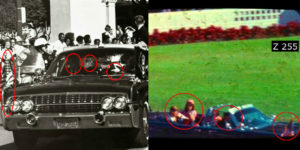

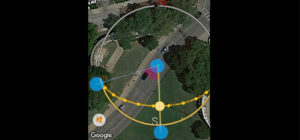
Mr. Altgens: The car never did stop. It was proceeding along in a slow pace (sic) and I stepped out in the curb area and made another picture as the Secret Service man stepped upon the rear of the Presidential car and went to Mrs. Kennedy’s aid. (7H518)
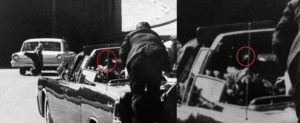
As can be seen the white mark is clearly visible in Altgens second photograph of the assassination sequence. Later at Parkland this photograph, taken at some distance and closely cropped here, the mark is less obvious. But it is in the same place. What’s more, it was described in detail by a bystander.
Windshield Hole Witnesses
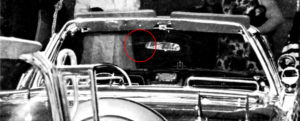
Dr Evalea Glanges was a first year medical student at Parkland. In an episode of the British made documentary series “The Men Who Killed Kennedy” this is what she saw;
“But it was very clear, it was a through and through bullet hole, through the windshield of the car, from the front to the back”.
“No way there’s even any cracks associated with that bullet hole, It seemed like a high velocity bullet that had penetrated from front to back in that glass pane”
In the same episode George Whitaker, Snr., a Ford employee at the Rouge plant in Dearborn Michigan also saw the hole. Incredibly, the Limousine had been secretly shipped there for a complete refit and the windshield was used as a template for a replacement before being destroyed. The replacement was suitably damaged but not to indicate a frontal shot. I believe this was necessary because Altgens photograph was in newspapers only hours after the assassination. The substituted windshield is in evidence held at the national Archives in Washington. This is Whitaker’s description.
“It was a good clean bullet hole right through the screen from the front, right, this had a clean round hole in the front and the fragmentation coming out of the back”
Dallas motorcycle patrolman Stavis Ellis observed a penetrating bullet hole in the limousine windshield at Parkland Hospital. Ellis told interviewer Gil Toff in 1971: “There was a hole in the left front windshield…It was a hole, you could put a pencil through it…you could take a regular standard writing pencil…and stick [it] through there.”
[David Lifton, Best Evidence.1988 Edition pp 370-371]
Dallas Motorcycle Patrolman H.R. Freeman, also interviewed by Toff corroborated his colleague Ellis, saying: “[I was] right beside it. I could of [sic] touched it…it was a bullet hole. You could tell what it was.”
[David Lifton, Best Evidence.1988 Edition pp 370-371]
Secret Service Agent Charles Taylor Jr. wrote a report on November 27, 1963 in which he detailed his activities providing security for the limousine immediately after the car’s return to Washington following the assassination. The JFK limousine and the Secret Service follow-up car known as the “Queen Mary” arrived at Andrews AFB aboard a C-130 propeller-driven cargo plane at about 8:00 PM on November 22, 1963. Agent Taylor rode in the Presidential limousine as it was driven from Andrews AFB to the White House garage at 22nd and M Streets, N.W. In his report about what he witnessed inside the White House garage during the vehicle’s inspection, he wrote: “In addition, of particular note was the small hole just left of center in the windshield from which what appeared to be bullet fragments were removed.”
[David Lifton, Best Evidence.1988 Edition pp 370-371]
St. Louis Post-Dispatch reporter Richard Dudman wrote an article published in The New Republic on December 21, 1963, in which he stated: “A few of us noted the hole in the windshield when the limousine was standing at the emergency entrance after the President had been carried inside. I could not approach close enough to see which side was the cup-shaped spot which indicates a bullet had pierced the glass from the opposite side.”
Frangible Rounds
A hollow point round will dump a tremendous amount of energy into the target in a very short space of time and distance. This causes massive temporary cavitation and consequently massive trauma. This type of trauma is graphically demonstrated in the frames of the Zapruder film showing the fatal head shot. Most experts agree that the round that struck the President was one designed to effect maximum damage. This may sound strange considering the fact that we are discussing a bullet aimed at a human being, but it is perfectly normal for ammunition to be selected that will tend to incapacitate or injure the target.
A question most often asked of my hypothesis (that a single shooter, situated directly in front of the target fired both frontal shots that hit), is “how could the same ammunition that behaved as it did in the head shot penetrate a windshield and still strike its target?”. The logic behind this question, an objection to the suggestion that the same shooter could have fired both shots, is that the ammunition for each shot must surely have been different. The explanation lies in the behaviour of hollow point ammunition.
A hollow-point bullet is an expanding bullet that has a pit or hollowed out shape in its tip often intended to cause the bullet to expand upon entering a target in order to decrease penetration and disrupt more tissue as it travels through the target. It is also used for controlled penetration, where over-penetration could cause collateral damage (such as aboard an aircraft). In target shooting, they are used for greater accuracy and reduction of smoke, fouling, and lead vapor exposure, as hollow point bullets have an enclosed base while traditional bullets have an exposed lead base.
Hollow points are designed to increase in diameter once within the target, thus maximizing tissue damage and blood loss or shock, and to remain inside the target, thereby transferring all of the kinetic energy to the target (whereas some fraction would remain in the bullet if it passed through instead). Both of these goals are meant to maximize stopping power. Jacketed hollow points (JHPs) or plated hollow points are covered in a coating of harder metal (usually a copper alloy or copper coated steel) to increase bullet strength and to prevent fouling the barrel with lead stripped from the bullet. The term hollow-cavity bullet is used to describe a hollow point where the hollow is unusually large, sometimes dominating the volume of the bullet, and causes extreme expansion or fragmentation on impact. In this case “impact” is first the windshield.
What remains of the projectile penetrated the throat but confused doctors because of its shallow penetration.
The characteristics described can be applied to Kennedy’s injuries as observed both at Parkland and later by Tom Robinson of Gawlor’s Funeral Home after the autopsy. He said when he applied embalming fluid to the cadaver it leaked through tiny holes in JFK’s face. It also explains why Charles Taylor Jr. observed bullet fragments in the windshield hole. Obviously we have no way at this late stage of knowing just what type of ammunition was used, but I am of the firm opinion that some form of high velocity hollow point was used. The late Sherry Fiester suggested privately to me that I should focus my attention on .223 ammunition. A Hollow point bullet, particularly one like a .223 high velocity round will leave casing and begin to fragment if it passes through laminated glass before it hits it’s target. Because it is necessary to demonstrate just how one person can fire two shots with seemingly different behaviour using one type of ammunition, I direct the reader to Sherry’s comprehensive explanation of the head wound. At this stage it is simply important to understand that if it hits a human target, it will produce instant and massive damage.
Where Was the Shooter?
This work is wholly indebted to Sherry who, in her book “Enemy of the Truth, Myths, Forensics and the Kennedy Assassination” became the first researcher to apply professional Forensic methods to the study of the head shot. For any serious student of the assassination, and in particular of the shooting sequence in Dealey Plaza it is required reading. That book places the shooter south of the triple underpass. Her book forensically debunked one theory perhaps most cherished by people who believe that Lee Oswald did not kill the President, namely that the fatal head shot originated from the North West corner of Dealey Plaza..the so-called “Grassy Knoll”, or quite often “The Stockade Fence”. For clarification, Sherry’s findings do nothing to invalidate the presence of a shooter in that location but they prove conclusively that whoever shot did not strike the President in the head.
There is one other factor of crucial significance concerning the behaviour of a projectile…any projectile…striking a windshield – deflection. the person firing this shot was not intending to hit JFK in the throat.
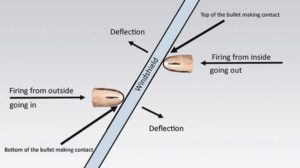
With that said, whoever it was must have used telescopic sights of some sort. It would have been beyond the capacity of anyone to attempt such a precise shot without one. There are simply too many obstacles between the shooter and his target and were much too distant to discern with the naked eye. The shooter’s view, aided by a telescopic sight, would, coincidentally, be very similar to Altgens 6.
Crucial Witnesses
The following statements were given to the FBI on 24/11/63 by Mr. Jack Franzen and 25/11/63 by Mrs. Franzen, eyewitnesses to the assassination.
Mr. Franzen: advised he and his wife and small son were standing in the grass area west of Houston Street and south of Elm Street at the time the time that the President’s motorcade arrived at that location at approximately 12:30 pm on November 22nd 1963. He said he heard the sound of an explosion which appeared to him to come from the President’s car and noticed small fragments flying inside the vehicle and immediately assumed someone had tossed a firecracker inside the automobile.
(22 WCH 840).
Mrs. Jack Franzen: Advised shortly after the President’s automobile passed by where she and her family were standing she heard a noise which sounded to her as if someone had thrown a firecracker into the President’s automobile. She advised at approximately the same time she noticed dust or small pieces of debris flying from the President’s automobile.
The Franzen Family


Firecrackers
When I first started studying the assassination one phrase struck me as significant because I kept reading it over and over. That phrase was “It sounded like a firecracker”. The large number of times it occurred was one thing that made it stand out to me but the other was how odd it was. Others disagree with me over this, but what I found odd was that on an American city street, in a State that was no stranger to gunfire, in a country unique in its tolerance of private weapon ownership and use, the first thought many people had was not that they’d heard gunfire but that they’d heard a firecracker. I come from and live in the UK, where until comparatively recently, gunfire was a sound totally alien to the average citizen. Not so the United States. Gunfire was and is something that whilst not exactly commonplace is also not something people would be so surprised by that they were unable to recognise it when they heard it.
Clinton J. HIll: November 30, 1963 statement (Secret Service agent on the left rear of JFK limousine grabbing Jackie Kennedy during assassination)
“The motorcade made a left hand turn onto Elm Street. I was on the forward portion of the left running board of the follow-up car. The motorcade made a left hand turn from Elm Street toward an underpass. We were traveling about 12 to 15 miles per hour. On the left hand side was a grass area with a few people scattered along it observing the motorcade passing, and I was visually scanning these people when I heard a noise similar to a firecracker. The sound came from my right rear and I immediately moved my head in that direction. In so doing, my eyes had to cross the Presidential automobile and I saw the President hunch forward and then slump to his left. I jumped from the Follow-up car and ran toward the Presidential automobile. I heard a second firecracker type noise but it had a different sound – like the sound of shooting a revolver into something hard. I saw the President slump more toward his left.”
[Statement: CE1024: 18H742]
Seymour Weitzman: (Dallas police officer, on the corner of Main and Houston Streets 1st April 1964)
“We heard what we thought at that time was either a rifle shot or a firecracker, I mean at that second.”
[Warren Commission testimony: 7H106]
Winston Lawson: (Secret Service agent in the lead car ahead of the Presidential limousine), April 23, 1964:
“I heard this very loud report which at first flashing through my mind did not say rifle shot to me. It sounded different than a rifle shot. It sounded louder and more of a bang than a crack. My first impression was firecracker or bomb or something like that.”
[Warren Commission testimony: 4H352)
Clifton Carter: (Secret Service agent in the third car behind the Presidential limousine, in front of the Texas School Book Depository at the time of the shooting), May 20, 1964:
“Our car had just made the left hand turn off Houston onto Elm Street and was right alongside of the Texas School Book Depository when I heard a noise which sounded like a firecracker.”
[Warren Commission affidavit: 7H474]
Welcome Barnett: (Dallas police officer holding back traffic and spectators at the corner of Elm and Houston), July 23, 1964:
“When the first shot was fired, I thought it was a firecracker ….”
[Warren Commission testimony: 7H541]
Jerry Kivett (Secret Service agent, three cars back from the Presidential limousine), November 29, 1963:
“As the motorcade was approximately 1/3 of the way to the underpass, travelling between 10 and 15 miles per hour, I heard a loud noise—someone hollered [sic] ‘What was that?’ It sounded more like an extremely large firecracker, in that it did not seem to have the sharp report of a rifle.”
[Statement: CE1024: 18H778]
All six of the above will have been familiar with gunfire. Seymour Weitzman had once owned a sporting goods store…selling, amongst other thing, firearms. These were all people who were also close to the limousine. Remember too what the Franzen’s both said, that whatever they saw and heard appeared to be happening inside the limousine. Other witnesses said something similar. These witnesses, including Victoria Adams and Roy Truly are not literally referring to bombs or cannons. They are referring to fireworks widely used at the time…for example, as Adams says, at football games. No two descriptions are identical, they range from very loud to “wasn’t real loud”, but the Firecracker descriptor is universal. Another term for such a device is a Cherry Bomb A rifle sound is very different from that of a Cherry Bomb in that it produces a prolonged echo. That may of course be due to location it is being fired in that particular demonstration. Dealey Plaza, an area surrounded by large, tall buildings would produce a different but not dissimilar sound, i.e. one that is more prolonged. The cherry bomb by contrast produces a distinctive, sharp “crack”.
Was It a Firecracker…or a Windshield?
There is one possible explanation for the widespread impression given of hearing a firecracker, that the rifle that fired the shot could have been suppressed. If that were so, the only noise many would hear would be the bullet’s impact with the windshield. It is a sharp “crack” not dissimilar to the cherry bomb.
The widespread use of the term Firecracker is in my view significant and whilst I accept that eye and ear witness testimony can be wide and varied, I include it here because in this instance I think it is proof of the sound of a bullet – a suppressed bullet, impacting a windshield.
Zapruder Tampering
Sherry Fiester’s analysis use of the Zapruder film draws the most criticism from those unwilling or unable to accept her conclusions. For these detractors, the Zapruder film is tainted evidence, ranging from tampered to outright forgery depending on the conviction of the proponent of that particular viewpoint. You will note that this study makes extensive use of the Zapruder film and it does so for the following reasons.
Having read the extensive work on the subject by former ARRB analyst Douglas Horne I agree with his conclusion that “In my view, the alterations that were performed were aimed at quickly removing the most egregious evidence of shots from the front (namely, the exit debris leaving the skull toward the left rear, and the gaping exit wound which the Parkland Hospital treatment staff tells us was present in the right-rear of JFK’s head)” and that “They did an imperfect job, the best they could in about 12-14 hours, which was all the time they had on Sunday, November 24, 1963, at Hawkeyeworks. Besides, there was no technology available in 1963 that could convincingly remove the head-snap from the Zapruder film; you could not animate JFK’s entire body without it being readily detectable as a forgery”. This from the man those suggesting the film is unusable as evidence cite as their champion. In their haste to “conspiracise” the film they ignore what the man whose work is most frequently referenced himself believes – That the film was altered cosmetically but the physics of the event it depicts is accurate and shows what actually happened.
Having watched and collected the work of Ant Davidson, who has skillfully and ingeniously created panoramic reworkings of the three most important films taken in the Plaza that day, the Zapruder, Nix and Muchmore films, it is obvious to anyone viewing them that at the moment of the head shot they all depict exactly the same thing. All of Davison’s work is in the video appendices section of my website www.jfksouthknollgunman.com
In “Enemy of the Truth” Sherry explains in great detail that the reason we only see back spatter from the head shots frontal entry for one frame is because its speed and composition is such that one eighteenth of a second is all it will be visible for to a camera lens at that distance. Besides, the phenomenon of back spatter was unknown in 1963 and so the reason it too wasn’t obscured or removed is because those who ordered the alteration probably thought its inclusion provided proof of a shot from the rear.
The subject of Zapruder film alteration is almost as complex as the assassination itself and cannot be covered in any detail here. But the film’s use here as a primary source of evidence for this hypothesis does require explanation for that reason. You can see Davison’s convincing renditions on my website . With all that said I will now lay out my hypothesis, marrying my own research with that of Sherry Fiester. As you will see, they are mutually supportive. JFK’s assassin stood not on the Grassy (north) Knoll but it’s opposite number… the South Knoll.
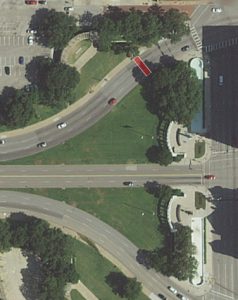
The curve of Elm Street itself, particularly in the area visible in the Zapruder film. As he pans his camera left to right the road curves with him. This gives an illusion we are following a vehicle in a straight line. The direction Zapruder is facing. He is stood at the south west corner of the north pergola and is facing the junction of Main Street (which runs horizontally in the lower half of the image) and Houston Street (which runs vertically at the right of the image). The direction the limousine would be pointed whilst traversing Elm Street as indicated by the vehicles in the image. Again, the Zapruder film gives a completely different impression of this direction due to the lack of background reference points. Your mind’s eye imagines a path more akin to that of main Street, especially when Main Street becomes visible in the film.
It is important to realise that Houston Street, the Elm Street spur that runs along the south edge of the School Book Depository Building and the equivalent road that runs along the north edge of the Terminal Annex building (just out of sight at the left of the image) are at the same elevation – 429 feet. Only the the north and south parking lots and the Triple Underpass itself are lower, 424 feet at the northern end, 422 feet at the southern end. Using an online elevation finder the area shaded in red on the previous image is also at 422 feet elevation. So from the spot this photograph was taken to the point at which the throat shot occurred as previously indicated the road surface drops by seven feet.
The Breakthrough
The following image was what enabled this whole hypothesis to come together, a true “Eureka” moment. I realised that with a known bullet hole, a known victim and direction of travel all that was needed was to orient the limousine in the correct position and bearing on Elm Street and the shooter’s location could be extrapolated.
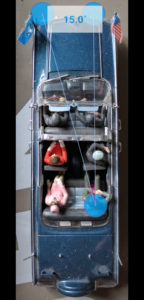
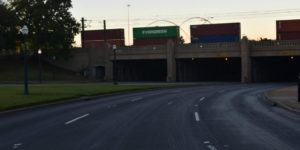
This photograph was taken at approximately 07:30 on the morning of November 20th 2016. With the help of several volunteers from the JFK Assassination Conference being held at the nearby Crowne Plaza on Elm Street I was able to stand in the position seen in the earlier composite images determining the shot zone on Elm Street. Volunteer helpers were keeping watch on the traffic signals behind me. My friend Scott Reid directed me into position on the street from where Zapruder had stood using visual cues (as depicted and derived from earlier photo composites). It took several attempts because of interrupting traffic (had we attempted this any later or on any other day it would not have been possible) but eventually we were jointly able to position my camera to enable me to take a photograph from a point on Elm Street I believed was the spot the throat shot had struck. The centre of the photograph depicts the direction of travel at that spot. The tripod I used had a fluid head which allowed measurement by increments of 9 degrees. In the centre of the road ahead you can just make out the “X” painted regularly by Robert Groden which marks the spot depicted in Zapruder frame 313 where JFK’s life ended. If you can believe it, people actually stand smiling and grinning on that spot having their photograph taken…I will make no further comment.
(Note: Calculation of this exact spot involved a complicated series of photo compositions too lengthy to include here. They can be viewed on my website www.jfksouthknollgunman.com. Meanwhile this image summarises the whole process nicely.)
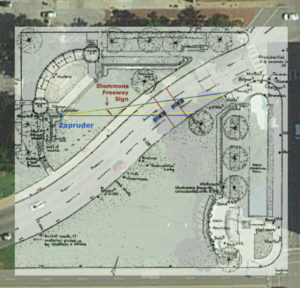
Remember the 15 degree angle established using the model limousine. It was now necessary to take a photograph at an angle of 15 degrees left of the one above.
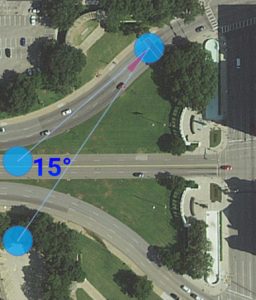
Using the scale on the tripod I turned the camera to the angle calculated in the above composite photograph. Next I used image editing software to place the yellow spot where the origin of the shot would be if stood on the edge of the Terminal Annex parking lot…dead centre of the photograph.
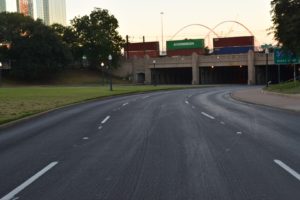
You will note that thus far I have assumed that the bullet responsible for the windshield hole must have been responsible for the throat wound. The reason for that is simple. There is one bullet hole and one wounded person. In reality there are only two possible locations for the person who fired that bullet, the north or south knoll. The only other possible location in-between is the Triple Underpass. If that were the case the shooter was both invisible and inaudible to the railroad workers stood on that bridge.
If the shooter was behind the stockade fence on the more famous “grassy knoll” then the resultant shot would not and could not have struck John Kennedy but would instead have hit one of the three occupants on the left side of the limousine. To assume a frontal windshield bullet hole during a Presidential assassination resulting in a wound to the intended target means drawing a straight line from one to the other. Occam’s Razor.
The Shooter’s Location Today
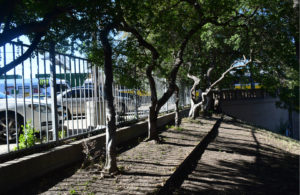
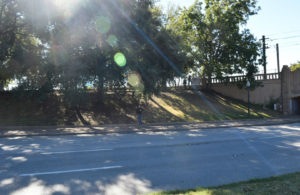
This is a view of the area the previous photograph was taken from. It shows just how far the tree foliage has been allowed to overhang. It is hardly conspiratorial thinking to wonder why it has been allowed to almost reach the heads of passers by on the adjoining sidewalk. This photograph (taken near midday) also illustrates how bright the sun is looking in that direction. From further away it only gets worse. It is impossible to look at the South Knoll from the north side of Elm Street without having to shield ones eyes.
The Perfect Match
If my hunch was right, that the shooter I believed I had now placed and that determined by Sherry Fiester were one and the same then using the same method on the spot where Zapruder frame 313 occurred should result in an identical location. I needed to replicate my experiment there too.

This composite image was produced by Sherry Fiester. It shows an oversized skull to represent JFK’s line of sight at the moment he was struck in the head as seen in Zapruder frame 313. The line drawn from the skull is at 25 degrees to profile and represents the direction he was facing – not bullet trajectory. Because of the military and political influence imposed upon the Naval personnel conducting the autopsy it is worthless as a means of honestly determining the actual bullet wounds. Sherry’s analysis skillfully uses the flawed autopsy report to prove where the wounds had to to have been on the head and uses blood spatter and many other measures such as skull fracture patterns to determine direction. Adding these two factors together still gives us, even with the carefully contrived official report, an entry point that had to be in the front right quadrant of the president’s head and an exit point in the right rear quadrant.
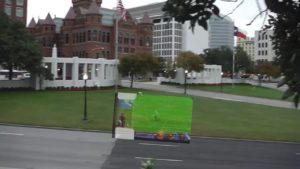
I produced this composite image by using a freeze frame of my own video footage taken from the small concrete abutment upon which Zapruder stood and superimposing the horrific frame 313 from his film over the place it happened. That spot is represented by an “X” regularly painted and repainted by veteran researcher Robert Groden. In simple terms, the original film has no visible points of reference. Without them a wholly different impression of the shot to the head and it’s point of origin is given. It is for that reason alone that the undisputed shot from behind the stockade fence has been assumed to be the origin of that fatal shot for half a century. The simple inclusion of background buildings shows that Zapruder was facing the junction of Houston and Commerce Streets. Because JFK was obviously tilted away from him in the still image (some 15 degrees) and facing 25 degrees from profile, a bullet entry and exit in the right quadrant of the head from an area which is in fact behind us and to our right in this image is demonstrably impossible.
Also note that this composite demonstrates the incline down which the limousine was traveling. This allows you to see how the fatal shot could have cleared the metal frame behind Kellerman and Greer. I urge you to watch “A Coup in Camelot,” which has computer graphics illustrating how the shot could also have passed under that metal frame. It must be remembered how audacious and accurate our marksman had already proved himself with the throat shot.
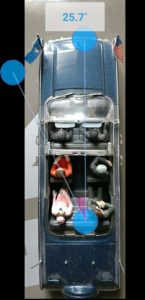
This image uses the same technique as that used for the throat shot to demonstrate the direction JFK was estimated to be facing at the point of bullet impact to his skull in Zapruder frame 313. Because the bullet entered and exited in the right half of JFK’s skull this estimated angle is going to be almost the same as the bullet trajectory. I have used the figure of 25.7 degrees from profile calculated by Dale Myers in his computer animation which supports the single bullet theory. The single bullet theory is a construct forced on the Warren Commission by its own insistence of only three bullets, all fired from the rear and as such is a nonsense.
Using Myers’ calculation for the position of JFK relative to Zapruder does not invalidate an anti single bullet (ie conspiracy) conclusion any more than showing a plane fly into tower one of the World Trade Center invalidates the argument that there were no Muslim Terrorists aboard that plane. Besides, the HSCA concluded that JFK was facing 25 degrees from profile so we are talking fractions of a degree. The use of Myers’ calculation still results in a shooter on the South Knoll.
Of greater importance is what the angle shows within the vehicle itself. The only person in this image in the path of the incoming bullet is Nellie Connally. In Zapruder Frame 313 both Nellie and John Connally, whom she has pulled toward her but downward are much lower in the vehicle than they were when sitting upright. If the trajectory shown reflects the actual shot fired this leaves us with two possibilities. Either the elevation of the shooter versus the elevation of the metal bar behind the Driver, Secret Service Man Bill Greer, was sufficient to give a clear sight of Kennedy or the shooter fired to Greer’s left and under the metal bar (used for the removable roof). One difference from image 007 is that the vertex – the point at which the angle is measured, in this case representing JFK’s head rather than throat you will note that I have estimated a position between that shown on the model and the figure of Jackie to illustrate that the President was leaning toward her at this point.
The idea of such an intricate bullet path is not as far fetched as it first appears when you consider that at the vehicle had come to a rolling stop and was either momentarily stationary or near stationary at the moment of impact. It must also be remembered that if my hypothesis that the throat and head shots were made by the same gunman, that gunman had already demonstrated the ability to fire an audacious shot through the car windshield from a distance of over 100 yard
This is the moment my hypothesis becomes apparent. Using my own figures to estimate the origin of the throat shot and those used by Sherry Fiester to estimate the origin of the head shot you will note that in all trajectory projections there are only a few feet separating the results. This can be explained by any combination of the following; For the Throat Shot
-
I have estimated the position of the bullet hole in the windshield using a model of the vehicle. a slight difference in location results in a slightly different angle.
-
The model may not accurately represent the position of the President in the vehicle.
-
I have estimated the direction of travel against which I have calculated the trajectory.
-
The position of the point on Elm Street used is the earliest the shot could have occurred. If it occurred slightly later the trajectory would differ accordingly.
-
This latter point is exacerbated by the curvature of Elm Street.
The same is true for the Head Shot:
-
I have used Dale Myers’ calculation for JFK’s line of sight. Using that of the HSCA would alter the outcome. Both are themselves estimates.
-
I have not corrected for the angle the bullet passed through the president’s skull. That need not match the direction he was facing, in fact it is unlikely it did. No matter how small the difference, projected over 100 yards the result is feet not inches.
-
Again, I have estimated the direction of travel against which I have calculated the trajectory.
-
It is possible the vehicle veered slightly at this point, as some have testified.
-
And in all instances using calculated estimates there is of course a margin for error.
-
What is most important is that the trajectory estimates all point to a very limited area – an area within the confines of the Terminal Annex parking lot.
As with the throat shot, for the head shot I took an image facing direction of travel as zero this time standing on the “Groden X” marked in the centre lane of Elm Street.

Again because of the 9 degree gradations on the tripod’s fluid head I could not easily replicate either 25 or 25.7 degrees from zero. However I could exactly measure 27 degrees and my logic for doing so runs like this. If 25.7 degrees was the direction JFK’s head was pointed from direction of travel (profile) at the instant he was shot, and the bullet entered his right temple (or right forehead as several witnesses reported) and exited the right occiput this means that the bullet itself traversed an angle, however small, versus the centre line of the skull. By erring on the larger of my alternative, accurate measurement choices I was likely to be closer than if I erred lower.
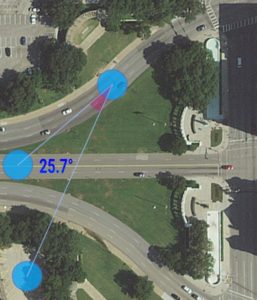
As before, the differences involved are sufficiently minimal to fall within acceptable margins of error. I again placed a yellow dot in the dead centre of the image at parking lot level.

There is massive irony in this next image. It was taken during the filming of the “JFK, Inside the Target Car” one of the countless mainstream propaganda exercises designed to slowly brainwash humanity into accepting white is in fact black. It shows the limousine, positioned by the program makers on Elm Street at the point of head shot. It needs no caption.

Witness
William Robert “Tosh” Plumlee was stood below the large tree to the left of the foot of the steps which are the mirror image on the south of the plaza of their more famous counterparts on to the north. This is his statement, given as early as 1966 to investigators.
“While on the south knoll, Sergio and I were attempting to evaluate the most logical places where shooters might be located, but everything was confused, the timing was off, team members were late getting into position. They were not where they were supposed to be and the limited radio contacts that we had with them were not working, or spotty at best. It was soon after our arrival that the motorcade arrived. When the shots rang out, I had the impression of 4 or 5 shots, with one being fired from behind and to my left on the South Knoll, near the underpass and south parking lot. While leaving via the south side of the underpass near the train tracks, Sergio and I smelled gunpowder.”
This was where Tosh stood…
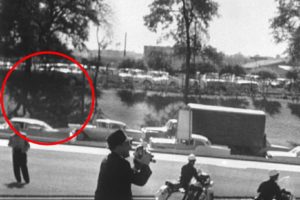
This was the map he produced for investigators…
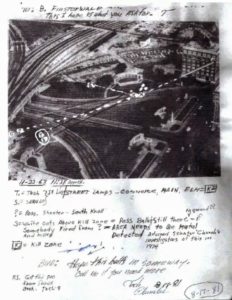 In the Final Analysis
In the Final Analysis
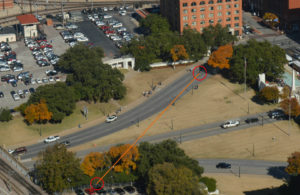
Whilst it is possible that this whole hypothesis is in error, it’s strength lies in the fact that it ties several disparate pieces of evidence. It’s weakness is that it challenges half a century of received wisdom. Because of this it has been resisted by many.
Some of that resistance is factually based, but none of it is backed by solid research such as is presented here. For example, it has been suggested that the neat entry wound in JFK’s throat is inconsistent with a ragged frangible bullet shard. Whilst that is in itself a reasonable objection it is incomplete. If true, and if the wound was indeed from a bullet fired not from the south knoll but elsewhere then any alternative explanation would of necessity need to explain two things.
Firstly, how did a bullet fired unimpeded into the President’s throat produce only a shallow wound and did not, like those of Connally, traverse in and out of the lesser obstruction presented by a thorax as opposed to a muscular chest cavity?
And secondly it fails to account for the actual trajectory of the bullet that made the windshield hole, including how and why it missed the other occupants and where the shooter was located.
It must be remembered, the intended victim of this attack was undoubtedly the President (Connally too may also have been a target, either in his own right or mistaken for Yarborough).
Taken as a whole, the existence of a frontal entry bullet hole, photographed a mere 1.6 seconds after the President is seen to suffer a wound to his throat (i.e. frontal, at the same height) at the exact same time what many thought were either firecrackers or gunfire was heard with as yet no injury to other occupants and, crucially, eyewitness accounts of debris seen flying inside the vehicle is very compelling.
How compelling only the reader can decide. But if they decide it is not, I insist they be as specific as I have been in explaining how and why.
For Sherry
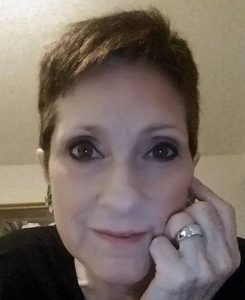
masterfully done!
Thank you, Excellent.
Alek ..On my last visit to Dealy Plaza, I spent quite a bit of time at the South Knoll area, going on Sherry’s work & Tosh Plumlee’s evidence of the smell of gunpowder from that area.
My thoughts :
The distance seemed far, but it did have its advantages. Getaway for one.
Invisibility for another, especially if using a silenced weapon.
The windshield shot definitely did not come from the Grassy Knoll. And the head shot angle does make sense as he was leaning towards that way, & it explains the hole in his right rear. I’ve always had a problem with the exit wound as the accepted grassy knoll location would seemingly have exited his left rear..not his right. The only thing that would seem to justify the right rear exit coming from the grassy knoll would be a previous ” instant before ” shot from the low Dal Tex location that opened up an avenue that it followed out. And this might have happened as well.
Initially I thought it the south knoll location was a bit extreme, feeling that a location on the southern corner overpass seemed better, but in looking at the overhead photos, it looks more plausible.
I’m sure there have been years of chuckling by the perpetrators as this southern location was overlooked for so many decades.. Thanks to Sherry for waking us up.
Although there of course were several shooting locations..they only had one chance to pull this off.. and they made sure they were successful
Plumlee, as I recall ,didn’t say what course he took in leaving & didn’t say where he & the “abort team” had parked or arrived from.. He just said they got out of there fast, & headed back to Redbird Airport.Minus Mr. Roselli..
The reason I bring this up is that it seemed like the breeze was lightly towards the south as the one photo shows smoke drifting from the grassy knoll towards the convergence of the 3 roads,towards the overpass.. Plummee didn’t stick around at all, so I suspect it wasn’t That smoke he smelled. It would have taken a bit for it to get to the south side. I believe him when he says he smelled gunpowder on this southern side, as he left. And I think this was different from the other photographed cloud going towards his side.
He also mentions looking at the lining up of street light poles as he looked for shooters.. I did this on my trip there.. Easiest way is to be up at the top of that side. Just surprised he didn’t see anyone there, since he was looking for that very thing. There’s not that much up there but trees(& cover)
What would have been interesting is if they had not had flight delays because of the weather. Would they really have had the authority to abort it , if they had arrived sooner?
Obviously, if there was an abort mission- there had to be a mission to assassinate JFK.
I know to this day he has his doubts whether he brought in some of the culprits disguised as an abort team. Roselli was definitely not there to stop it..
And as to the grassy knoll- I’ve photo’d the Mary Moorman picture from an enlargement, & see 3 guys behind the fence. One being Harrelson with a white shirt & tie on holding what looks to be a camera (maybe?) Something’s at his chest level
I know it’s Harrelson because I’ve seen a photo Michael Brownlow had of him & Files standing together in some room- only difference is he’s wearing sunglasses in the Moorman photo & some kind of turned around white hat.
Someone shot another better film than Zapruder that day. I’ve heard for years that the Gov’t. filmed it themselves. I’m sure you’ve heard about “The Other Film” as it is called, that circulated on some college campuses before the Dick Gregory showing of the suspect Zap. Film. The “Other Film” had the whole botched turn on to Elm,& the 3-4 second STOP of the Limo ( till Greer saw the head shot)
Also in the Moorman shot-on the fence left of Harrelson is another guy in shooting mode.. then left of him is another face.. Between them is some cylinder shaped object on the fence top (maybe a spotters scope?) metallic w/ pretty big round end (maybe 2″ in diameter)
How come I can see these guys & no one says anything about this? I don’t think I’m crazy..
Of course you can see the well known Badge Man in the same photo behind the concrete low wall on the other side of the stairs.
But when I showed Michael Brownlow this picture, he said this white shirted & tie guy with the sunglasses Wasn’t Harrelson. He said Harrelson was shooting from the top of the fence as it ends-toward the railroad yard.
Any thoughts on these points?
Thank you for letting me ramble
Alek.. P.S. The people I see in the Mary Moorman photo came from some experimentation with different levels of light and just using my phone’s camera, taking pictures of that photo from the “Four Days” book 1964. It’s a 2 page blowup of her photo
In reviewing the Zap. Film ( if we can believe it) , just previous to the head shot, Jackie moves rapidly foward and in front of JFK’s left face. This seemed to obscure any chance for a shot coming from the south knoll for this head shot.
But the location & angle is pretty convincing for the windshield /throat shot
Thank you. I admit the shots were audacious, but take a look at the Moorman photo to see that although close, Jackie does not obscure JFK’s face from the South Knoll shooter. I don’t want to become one of those people who takes a position on a particular aspect and then try’s to defend it against all comers, no matter what.
This theory “works” because it is mutually supportive. The origin of both shots can be estimated using mathematics. The witness statements support it. The visual evidence supports it and Tosh Plumlee’s testimony is, for me, the clincher.
I’m still open to it, for sure, Alek- so much of this makes sense..
I’ll be back in Dallas soon. Last time there, I met a man who had an office on the 3rd floor of the Dal Tex bldg. He took me up there. I was so excited, but we didn’t seem to locate that exact area that is a suspected shooter location obscured by the fire escape, which is gone now. ( it was late at nite) . Some doors were locked, being other businesses.but it was cool getting up there none the less. interestingly enough though- this man is young- probably 30ish- & he didn’t know it was even called the Dal Tex bldg. or that Zap. had his business there & showed the 1st viewings of his film in one of those offices..wish there was some kind of tour of that bldg- but considering how much The 6th floor Museum changed & ruined the DSBD, maybe it’s for the better..
Anyway, thanks for replying Alek..
Precisely. Throat shot was from the front.
Head shot was from behind the Grassy Knoll.
Does anyone concern themselves with Newtonian laws of physics? The back left movement of the President plus what deaf mute Texas Instruments employee Virgil Ed Hoffman witnessed—a gunman and his assistant shooting a rifle with a brown wood stock, the gunman throwing the rifle to his assistant then running north into the railroad yard area plus more witnesses reveal a gunman shooting from behind the Knoll and he was a deadly aiming shooter.
the head HIT came from the south knoll as well. as the limo proceeded on down Elm, the angle and elevation (it was now lower) of the limo relative to the south knoll shooter made the shot around the windshield (not through it at the throat HIT) possible. again, place the limo on plan. it was pointing at the bridge/south knoll intersect. the Z film is very deceiving in that the limo seems to be going in a straight line. it’s not. Zapruder pans it as it curves on Elm. he had to. he was stationary at a point. JFK was perpendicular to a grassy knoll shooter at the head HIT. yes, shooters and shots were all over the place.
Though this is all a great and sensible read, I am quite bothered by one particular issue; Why would a South Knoll Shooter ‘risk’ the kill shot he knew he was about to get for a shot through a windshield that would have simply incapacitated his target????
Agree with you that shooters fired at JFK and one shooter from South Knoll struck JFK ‘s front neck
and shooters were all over the place. I so far conclude
that the fatal head shot was one hit not two plus. Newton’s conservation of momentum
plus Virgil Ed Hoffman and other witnesses
appear to confirm one head shot from at back side of picket fence behind Grassy Knoll. I understand that there are many details that I am not yet addressing here. I have studied this case for over 40 years, I worked along side Mark Lane and one of his key assistants for five days, I met and spoke at length with Jim Garrison. I was also a friend of one of Mark Lane’s assistants for two years. Also attended more than one session of the House Assassinations Committee hearings. I helped lobby Congress to create the Hise Assassinations Committee when it became counseled by Richard Sprague. There are so many details worth addressing and more worth learning. We need a real grand jury to review this unsolved murder case. And a tough prosecution team. Don’t stop in your efforts.
I commend you on your efforts and am jealous of your meeting and speaking with the great Jim Garrison (please share). i was 12 on 11/22/63 and have waxed and wained through the decades. consider that JFK was looking at the south knoll and the entry at the temple and exit out the lower right of his skull could only happen from that direction. years of looking at the deceiving pan of the Z film as the limo travels along the curve of Elm makes indelible impressions, but they’re wrong.
Was 8 in 63 21 when I met Garrison and Lane separately, Garrison at Lane’s DC office
and Lane in two different parts of Illinois
for two different events, one of which ZI coordinated for and with Lane. I also met
Tip O Neil , Gerald Ford and Walter Mondale
Same year. I also lived in DC 1978 and 1979.
and associated with folks who lived near
Mary Meyer and JFK and RFK.
Dennis. any anecdotes would be appreciated on your meetings.
The 2017 update about the throat shot is most significant.
No details like the current throat shot information was
ever provided lawyers like Mark Lane, Garrison, etc..
I still believe the head shot came from the Grassy Knoll area.
Newtonian laws of physics thrusting the body of the President
quickly back and left were from the right side of his vehicle,
not from the South Knoll gunman position. Agree that there were
gunmen on three sides of the President at a significant enough distance,
not close range, and not from any gunman inside the Presidential limousine.
Dennis, if there’s a shooter at the south knoll who made the throat hit (deflected by the windshield), and the limo is crawling toward him, and lower and at a better angle, why isn’t he the one with the head hit? i think decades of history and personal involvement is making it hard for you to change on the grassy knoll shooter head HIT (and i definantly think there was a shooter on the grassy knoll) per witnesses and the smoke. the head shot would have been perpendicular from there. look at the plan view.
I saw the plan view. More than once. I know you and others know
there was a shooter in the picket fence area near or behind the grassy
knoll. But what do you do with the witnesses like Hoffman and the
Acoustics evidence regarding the head shot?
Thank you, Reuel, any good British gentleman ,as I am not since I am an American,
would know that the most brilliant mind at Cambridge was Sir Isaac Newton.
the founder of the Newtonian Laws of Physics. Though we could reference
Einstein’s theories trumping Newton’s, at least on 11/22/63, God’s physical laws
discovered by Newton applied in Dealey Plaza. I believe that the good analysis
I read and re read from Alek Hidell
has it perfectly and fully correct on the JFK neck shot. Not so, in my view, on the head shot. JFK’s fatal
head wound came from somewhere in the Grassy Knoll area. Mr. Hoffman saw
the shot and described the red Jello color on JFK’s head immediately afterward.
I am not ready yet to concede on this one. There were at least two Secret Service
Agents who also saw the shooter behind the grassy knoll as well whom did not tell or inform
our investigative boards about. That shooter did not miss. Furthermore, I do not see the Limo turning right enough as
you do, by weaving or otherwise. Of course, we don’t know what JJ Humes originally wrote since he
burned one maybe two sets of his autopsy notes. However, I was in on an attempted murder case, in 1990,
and know first hand that at hospitals several medical personnel must have been on hand to see X rays and or photos
taken of the President and in JFK’s case several of them were in
Trauma Unit One all over his body trying to save him. Ask them for their view of
the head wound. We already know some of it by Dr. Crenshaw. I knew a relative of Dr. Peters I believe
that is what his name was, that relative assisted me when I assisted Mark Lane’s presentations in Illinois.
That relative doctor motivated the relative whom assisted me to help present a conspiracy case before
thousands of people in Illinois in 1975 and 1976 under my direction. Point is the medical personnel living
know about the head wound, entry and exit. In addition, Reuel, what do you do with the acoustical
evidence from the policeman’s open mike, that is what persuaded Blakey and others to conclude not only a conspiracy,
but a gunman who was firing his assassination weapon not from the South Knoll at the time JFK was hit in
the head, but behind the Grassy Knoll. Are you going to also take on the acoustical evidence showing exactly
where the fatal head shot came from and precisely when? How do you address acoustical evidence
well analyzed by top notch national if not world experts?
Is it safe to say, nonetheless, that the South Knoll Shooter was about to take the final shot (i.e. I’m the guy who just asked you why he would have taken the ‘windshield’ shot to begin with). I just see no ‘gain’ in the wounding of the target before the kill….
Reuel, I understand what you are saying on the South Knoll shooter,
first shooting JFK in the neck, and really wanting to hit him more
fatally, so then he zeros in on the so called better shot to
the head. I get it. I was trained in law enforcement.
I just cannot dismiss Hoffman’s view of the shot fired and
the red jello appearance on JFK’s head plus the two Secret
Service agents seeing the same rifle shooter(who was assisted by
a non shooter who had a pistol who did not fire his pistol) and the
HSCA Acoustics Evidence. Bottom line, no matter how we debate this
aspect of the case, Oswald was set up by our government with a Manlicher Carcano
that he never purchased and therefore never owned. And so we smell a very dirty rat
in our government, not only in obstructing justice and letting others get away with murdering
our President whom my parents and in laws voted for, an American President who never had his day in court for obvious reasons nor did his grieving relatives, for less obvious reasons. And for the injustices
of this case in sum, several of us are still upset and see the hand of history possibly repeating
itself again, because past wrongs have not yet been corrected or fully adjudicated.
If Tosh was standing where he said he was he should’ve seen the shooter, there’s no where to hide!
Tosh was further west and lower almost at street level.. the shooter was at the higher parking lot and toward the bridge. the shooter was behind him. you can see them both in a blow up of a photo looking at the south knoll second after the shooting. http://www.jfksouthknollgunman.com
That was what I thought also.. There isn’t much cover over there… Only at the very top. But I do believe him. Have even seen a map with his name at that spot, low, on the South Knoll.. But if he was there looking for a shooter, it’s possible he was concentrating on locations in front of himself, rather than behind, figuring it would be a long distance from that location.. which it is..
like i said, look at the site i gave you and look at the blow up of the pic. you can see 3 people. Tosh, assoc, and the shooter standing and looking about 1 min after the shooting. easy cover for a shooter from the parking lot in the back of the van. one was parked there. and this was behind and above where Tosh was standing.
Gotcha Reuel, It all makes a lot of sense. Didn’t know about the van there. And no one would suspect a shooter over there, except that the ballistics do make sense for both neck & head trajectories, as JFK was leaning and pointing in that direction at the point of head wound. Thanks to both Sherrie & yourself Reuel
Alek,
Not sure whether it’s too late to correspond here, kudos for pulling together this work. Everyone interested in the JFK assassination will benefit from your insights and appraisal of events. The South Knoll deserves more scrutiny than it receives.
My professional background is in Architecture and urban planning. I first learned about the ambiguities of the JFK murder back in 1988 (the 25th anniversary) when I was a student in Boston. However it wasn’t until the 50th anniversary nearly five years ago that my interest was renewed largely because of the resources and speed of the internet. For example, the stabilized Zapruder film on YouTube has been especially useful in trying to determine (for myself anyway) from where in Dealey Plaza the President was subjected to gunfire and how his bullet wounds were sustained.
The long & short is that I share and support your hypothesis, it is absolutely THE underinvestigated scenario, and I can add a unique twist. First though, let me outline that in viewing the Stabilized Zapruder film back in 2013 I was struck by the location of JFKs head position relative to the South Knoll. My design background compelled me to examine the unique andperplexing characteristics of Dealet Plaza with an urban planners eye. Clearly, a South Knoll shooter would be at least, if not more proximate to the President as was alleged LHOswald would be when perched on the 6thfloor of the TSBD.
I was thrilled when the late Sherry Feister produced her work; thinking which remains very much in line with, and coincident with my views (of which you may access on the JFK facts web-site in response to Jeff Morley’s question: “Where did the shots come from”…. in which I develop my own hypothesis on the actual physical/concealed location of the shooters (Alas, they weren’t hiding in a storm drain! : )
Specifically, and in conjunction, I posit that so-called “Dark Complected Man”, and indeed “Umbrella Man”played a nefarious role as accomplices, providing target guidance as they stood opposite the south knoll relative to the limousine.
I can elaborate. I hope we’ll have an opportunity to trade notes and discuss probabilities, perhaps over the next few weeks/through the holisays.
Cheers,
Michael
…and my apologies for the typos! : )
Dear Alek, perhaps this comment has already been made; but if not, here’s a thought. If a bullet passed through the windshield and wounded JFK in the throat, and if (as I understand), no bullet was found in JFK’s body – then that bullet must be buried in the soil near the north pergola. Has anyone excavated that area?
Correction to my previous comment: if a bullet fired from the south knoll (a) passed through the windshield at the point where witnesses reported, and some photos show, a hole; (b) hit JFK in the throat; and (c) did not lodge in JFK’s body, then it must have narrowly missed Altgens and followed a trajectory approximating the viewpoint of Altgens 6. I presume that we can exclude an onward trajectory into the crowd outside the TSBD. Then it must have hit either the back seat of the limousine, or the trunk.
However if a subsequent bullet, fired from the same position on the south knoll, (a) caused the fatal head injury, and (b) did not lodge in JFK’s head, then that bullet is, to this day, buried in the soil below the north pergola.
I’m new to this new theory but have been sold. As a shooter and veteran [medic] who has followed the research into the assassination for more than thirty years, there were some nagging inconsistencies regarding the shooting position(s), shot placement, and wound channels. Namely, JFK’s head position at the point of the coup de grass.
At first, I thought such a theory SW was way out there. It wasn’t until I realized the distance and angle to the slow-moving target(s) would be child’s play for most semi-trained shooters. Assuming the mechanic(s) who were involved weren’t amateurs and assuming that the rifles were serviceable not to mention fitted with scopes, such a shot or shots would have been spot on. Hell, I could make a good accounting with iron sights without the aid of a scope.
That leads to some very serious conclusions if the theory is correct and I believe it is, I have to wonder “Was LHO the only patsy set-up that day?” Think about it, if you were planning to shoot at the president that day, “Where would be one of the worst places to do so”? What would be the hardest place to get away from, without being caught? . Every military ambush has a “rallying point” or fallback position or a get-away route. You wouldn’t want to be exposed. In other words cover and concealment, out of sight, out of mind. Not boxed in without any means of exfiltration.
I would suggest the worst place for any provocative and or executive action would be the Grassy Knoll. The shooter would be completely exposed. Not to mention would have only one avenue of escape.
Remember the Three Tramps? Why would anyone suggest or order them to loiter in the area prior to the assassination and then proceed to stationary boxcars and not flee after the assassination?
On the other hand, the SK would be the perfect spot. Ease of infiltration and exfiltration. Reasonable cover and concealment. An elevated plain and away from most of the crowds and obscured from anyone in the buildings to the south and those on the overpass.
It’s a sniper’s dream.
May I fully agree except for one thing: Why did this shooter take a ‘windshield’ shot rather than wait a couple seconds for a clean kill (i.e. he ‘risked’ leaving his target wounded at best) ?
Seems like a good question , Steve.
I would only imagine he felt confident enough that the 1st shot was worth the risk… but the defection of the windshield probably caused the bullet to drop to his throat. I’m sure he wasn’t aiming there.
There was a very short window of time here.. And it’s not everyday you get to shoot at the President.
Frank Cancellare photo #4 clearly shows two people in a car, Hats on, on that exact spot and they appear to be parked over the drain lid which is now filled with concrete. One appears to be holding a rifle in the process of being withdrawn. No experienced shooter is going to take tangential shot at a target who’s sitting next to the one, who can’t be harmed.
I’ve been shooting NRA rated expert since 1968, and I can easily demonstrate it today. Everyone had to be involved in this. Why is Clint Hill the only one wearing a vest that day?It’s clearly visible when he shoves Jackie back in the car. The z film doesn’t show the shove but the Nix film does. There is no brain matter on the trunk. She’s clearly unassing the QM because she knew it was a hornets nest. Read the new book, “The Inheritance”. Everything you want to know is right there.
fyi the 2 hits from the sk line up with existing back then street lamp poles (presited monuments with cars going by in earlier days for the assassin) and perhaps volley locations from the “scare ” group). why scare group? why so many wild misses amid the 2 great shots? imo 2 groups. 1 to wound/scare (JFK’s shallow back wound probed to 1″, Connally, Tague, infield bullet, windshield frame, shot from grassy knoll hitting nothing (would have been perpendicular to JFK’s head with Jackie’s behind) etc). scare= Cuba invasion 1 group at sk to kill=. LBJ Vietnam. so the first shot was sited in through the windshield. remember Dallas weather was and is all over the place in Nov. the top being on would have been planned for. also remember, JFK was sitting further back in the 3 row limo than a normal car. when told about the throat hit, not the head, the sk shooter pro calmly shot around the windshield and by Greer and his open side window as the limo inched along and came to a rolling stop. the shot was 100 yrds and easy for a world class pro. by the time of the head hit, the limo location was lower and more to the side for the sk shooter. so hitting the throat and not the head was a defection mistake by the shooter.
Engaging presentation. The throat wound, the windshield bullet hole, and the triangulation “plan” all come together to form as real a fact as any in this tragedy.
The assassination was a national tragedy. In some ways an international embarrassment. It will always have a mystery and a gray aura around who and why. It was a serious fail by our Secret Service, who on that day was worth nothing. An evil thing won that day and we can never change that. God Bless my Beloved Country, My Heart Was Broken.
I just watched the 1 hour and 13 minute version explaining the South Knoll Gunman theory-its very compelling nd hard to argue against. I have always believed that their were multiple gunman in various locations. The 3 situation theory is a tough one as it would have been very difficult to put all 3 in motion at once As with all theories there are always questions- 1. Who shot Connally? Was it Oswald? Was that his intended target? Someone fired from the TSBD- was he put there so h would b caught based on the most difficult route or escape and him being a known employee who was seen with “curtain rods” on his way to work. 2. Why didn’t anyone flinch when shots coming through the windshield were very close to the 2 agents up front, Mrs. Connally and Jackie. 3. Is the story from Tosh Plumlee proved and accurate? 4. If the South Knoll shooter missed his “kill shot” then Kennedy would have survived- the assassination group put quite a bit of stock in this one shooter to get the job done at what proved to be a difficult angle with precise timing. 5. Knowing nothing about firing a gun would he have had to anticipate the car moving and fire a split second ahead of his target? Is that why it was a perfect “strike” because the car slowed when that was not anticipated?